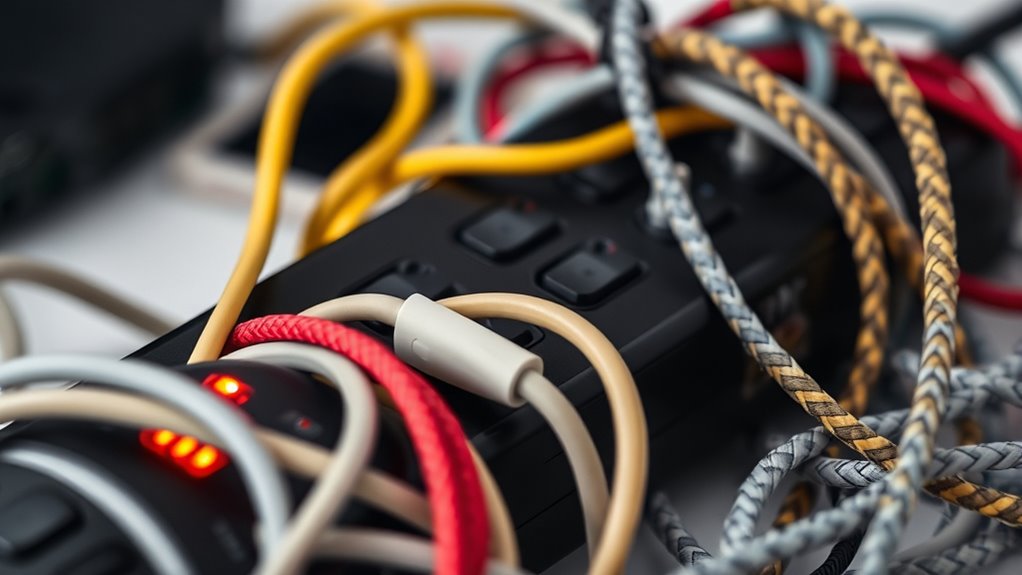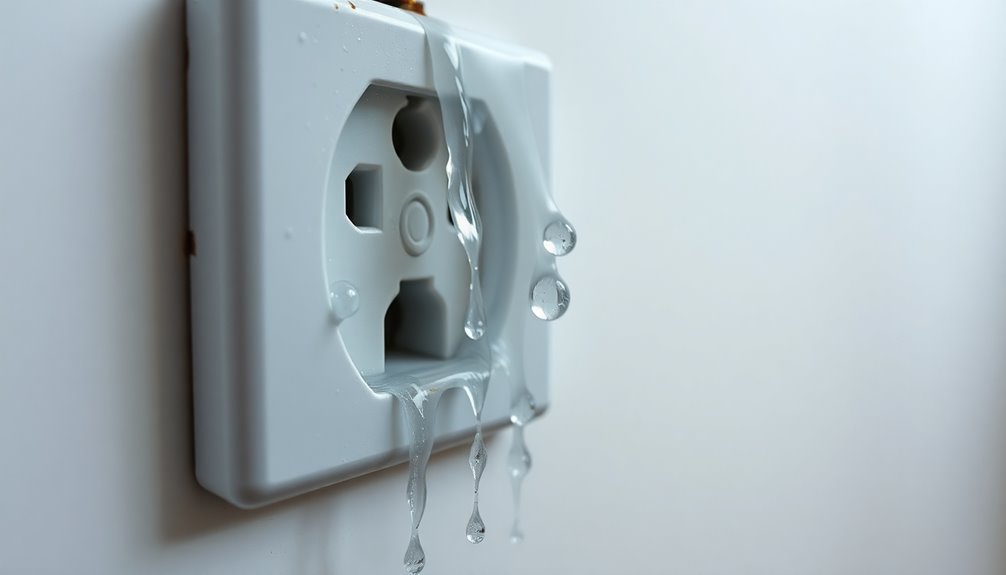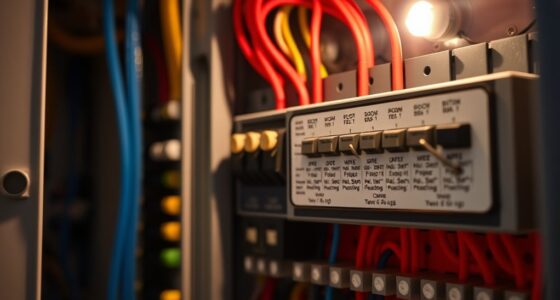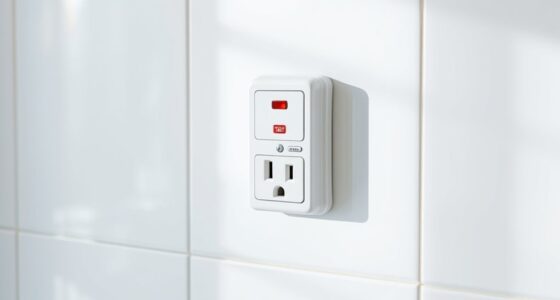Surge protectors and power strips are different tools for your electrical needs. Power strips simply give you extra outlets, while surge protectors add safety features to guard against voltage spikes that can damage your devices. If you want to protect sensitive electronics, a surge protector is the best choice. For temporary use or low-risk appliances, a power strip works fine. Keep exploring to learn how to choose the safest and most efficient option for your setup.
Key Takeaways
- Surge protectors include components like MOVs to guard against voltage spikes, while power strips do not.
- Power strips expand outlets for convenience; surge protectors prioritize device safety with surge absorption features.
- Surge protectors are suitable for sensitive electronics; power strips are better for low-risk, temporary use.
- Surge protectors have rated joules for energy absorption; power strips are rated in amps for current capacity.
- Using surge protectors properly helps prevent damage from power surges, whereas power strips mainly offer additional outlets.
Understanding the Basic Functions of Surge Protectors and Power Strips
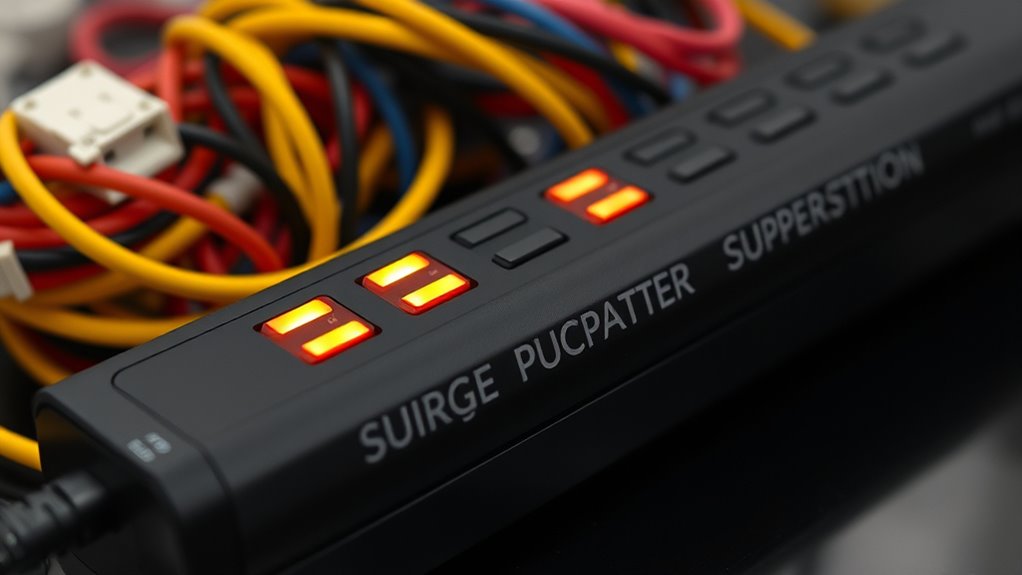
While both surge protectors and power strips allow you to connect multiple devices to a single outlet, they serve different purposes. A power strip simply provides extra outlets, giving you more space to plug in devices. It doesn’t protect your electronics from power fluctuations. Surge protectors, on the other hand, include components that guard your devices against sudden voltage spikes caused by lightning or electrical faults. When a surge occurs, a surge protector diverts excess voltage away from your connected devices, preventing damage. The primary goal of a power strip is convenience, offering additional outlets. Surge protectors focus on safety, shielding your electronics from potentially harmful power surges. Understanding this basic difference helps you choose the right device for your needs. Additionally, incorporating creativity in practice can help you better understand and evaluate the different features of these devices to make informed decisions.
Key Features to Differentiate Surge Protectors From Power Strips
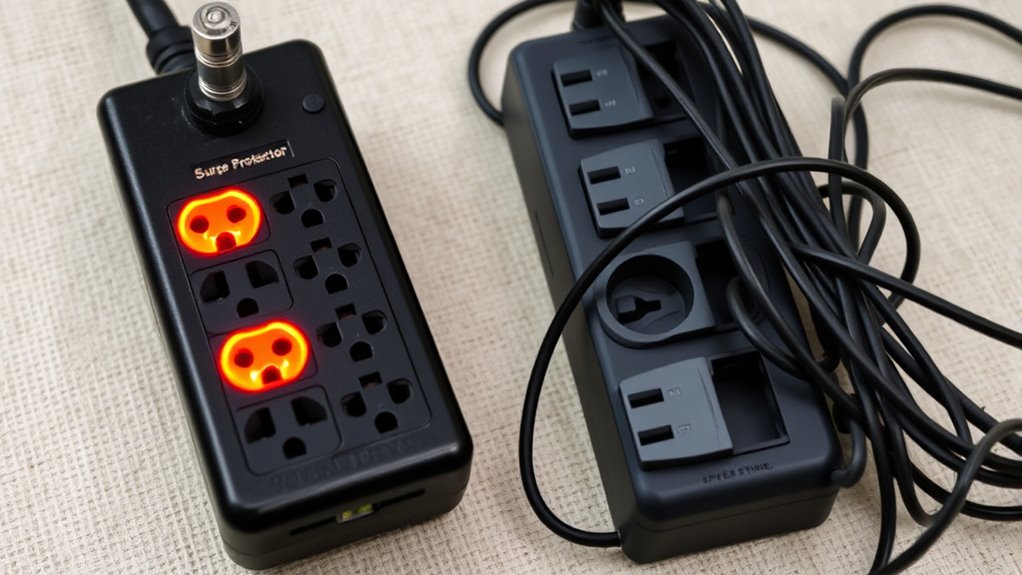
You should look at whether a device has built-in surge protection, which helps guard your electronics from voltage spikes. Safety features and proper certification also matter, ensuring the product meets quality standards. These key features help you tell a surge protector apart from a simple power strip.
Built-in Surge Protection
Built-in surge protection is a key feature that clearly sets surge protectors apart from standard power strips. When you choose a surge protector, you’re getting a device that actively guards your electronics against voltage spikes, often automatically responding to power surges. This integrated feature helps prevent damage to your devices, saving you money and hassle. Power strips, on the other hand, typically lack this protection and only distribute power without responding to surges. The surge protection mechanism in a surge protector usually includes components like Metal Oxide Varistors (MOVs) that absorb excess voltage. By investing in a surge protector with built-in surge protection, you ensure your valuable electronics are shielded from unexpected power fluctuations, providing peace of mind and enhanced safety for your devices. Additionally, contrast ratio plays a significant role in the overall image quality, especially in home cinema setups.
Safety and Certification
Safety and certification standards are key factors that set surge protectors apart from basic power strips. Surge protectors usually carry certifications like UL or ETL, ensuring they meet strict safety and performance guidelines. These certifications mean the device has undergone rigorous testing for fire resistance, electrical safety, and proper grounding. Power strips often lack these certifications, which can pose safety risks if used improperly. When shopping, check for clear labeling and certification marks; these indicate that the product adheres to recognized safety standards. Choosing a surge protector with proper certifications gives you peace of mind, knowing that it’s designed to protect your devices safely and reliably. Always prioritize certified products to minimize risks associated with electrical faults or fire hazards. Additionally, certified devices may include built-in safety features, which further enhance user protection.
How Surge Protectors Shield Your Devices From Power Surges

Surge protectors defend your devices by absorbing excess voltage during power surges, preventing damage. They use a surge absorption mechanism that redirects sudden spikes away from your electronics. Additionally, voltage regulation features help keep the power flow steady, giving you extra peace of mind. Implementing AI-driven analytics in designing surge protectors can further optimize their ability to respond to unpredictable power fluctuations.
Surge Absorption Mechanism
When a power surge occurs, surge protectors act quickly to shield your devices by absorbing the excess voltage. They contain components that redirect or dissipate surge energy, preventing it from reaching your electronics. The core mechanism involves a metal-oxide varistor (MOV), which reacts instantly to voltage spikes. The MOV absorbs high voltage and converts it into heat, safely dispersing it away from your devices. Additionally, some surge protectors include:
- Capacitors that absorb and store excess energy temporarily.
- Gas discharge tubes that ionize and divert surges beyond a certain threshold.
- Transient Voltage Suppressors (TVS) that clamp voltage spikes rapidly.
Together, these elements work to protect your devices from damage, ensuring that surges are neutralized before they cause harm. Sustainable technology is increasingly integrated into surge protectors to enhance their efficiency and environmental impact.
Voltage Regulation Features
While surge protectors quickly absorb and dissipate excess voltage through components like MOVs and TVS devices, their ability to maintain consistent voltage levels also plays a key role in safeguarding your devices. Voltage regulation features assure that your equipment receives a stable power supply, preventing damage caused by voltage fluctuations. Some surge protectors include built-in voltage regulators or automatic shutoff mechanisms that activate if voltage levels become too high or too low. These features reduce the risk of electrical stress, overheating, or component failure. By stabilizing voltage, surge protectors help extend your devices’ lifespan and improve their performance. Additionally, cultural intelligence emphasizes the importance of understanding and adapting to different technical standards and practices across regions, which can be crucial when selecting electronic equipment globally. Not all protectors offer this feature, so if consistent voltage is important for your setup, choose one that prioritizes voltage regulation alongside surge absorption.
Safety Considerations When Using Power Strips
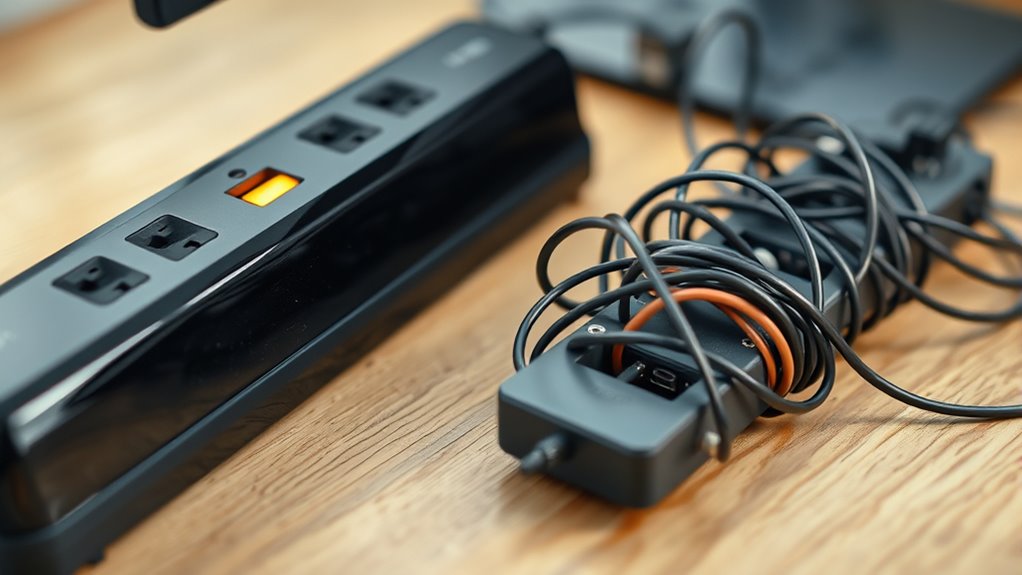
Using power strips safely is essential to prevent electrical hazards and potential fires. You should always follow best practices to protect yourself and your devices. First, avoid plugging in more devices than the strip’s rated capacity to prevent overloads. Second, keep power strips away from water, moisture, or heat sources to reduce the risk of short circuits or fires. Third, regularly inspect your power strips for damage, such as frayed cords or scorch marks, and replace them immediately if you notice any issues. Additionally, never daisy-chain multiple strips together, as this can quickly surpass safe load limits. Properly choosing trustworthy brands can help ensure safety and reliability. By practicing these safety measures, you guarantee your environment remains safe and your devices operate reliably.
Power Capacity and Load Handling in Surge Protectors and Power Strips

Understanding the power capacity of your surge protector or power strip is essential to prevent overloads and potential electrical hazards. Your device’s maximum load capacity indicates how much current it can safely handle at once. Exceeding this limit can cause overheating, damage to connected devices, or even electrical fires. Surge protectors typically have higher load capacities due to their design, often rated in joules for energy absorption, while power strips focus on current ratings, usually in amps. Always check the specifications printed on the device’s label. Distributing your devices’ power load evenly across multiple outlets helps avoid overloading. Remember, never plug in devices that collectively draw more power than the rated capacity. Staying within these limits assures safe operation and prolongs the lifespan of your electrical equipment. Additionally, understanding electrical load capacity is crucial to ensuring your setup remains safe and efficient.
Design and Construction Differences
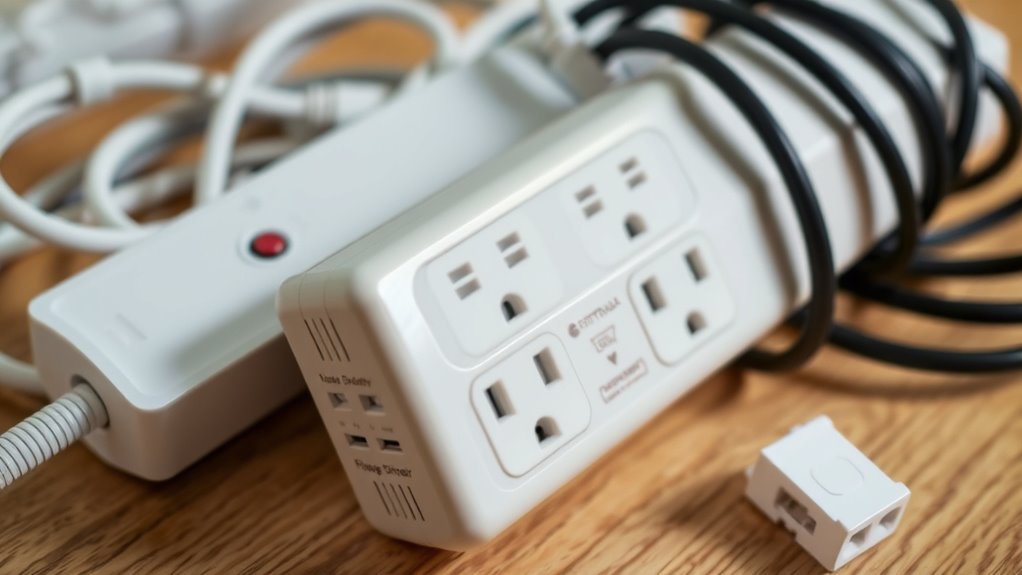
The design and construction of surge protectors and power strips differ markedly, reflecting their distinct functions and safety features. Surge protectors include components like metal-oxide varistors (MOVs) that absorb voltage spikes, while power strips lack these internal protective elements. They are built with simple wiring and multiple outlets, focusing on expanding power access rather than protection. Additionally, surge protectors often incorporate community engagement features like indicator lights to show protection status, enhancing user safety and awareness.
When to Use a Surge Protector Versus a Power Strip
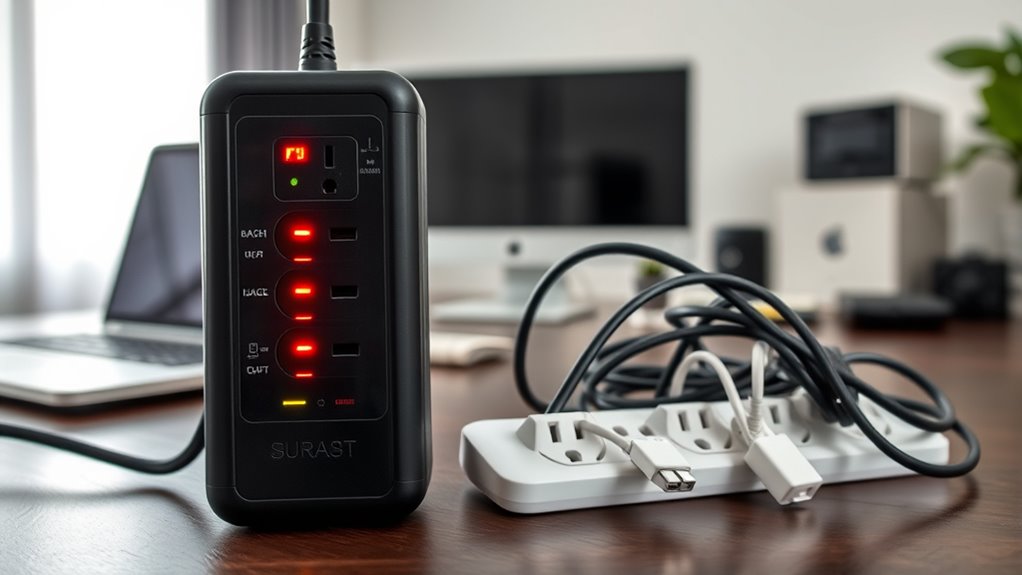
Choosing between a surge protector and a power strip depends on the devices you need to connect and the risks involved. If you’re plugging in sensitive electronics like computers, TVs, or audio equipment, a surge protector is the better choice because it shields your devices from power surges and voltage spikes. Use a surge protector whenever stability and safety are priorities. On the other hand, if you need to expand outlets for low-risk appliances such as lamps or chargers, a basic power strip works fine. Power strips are suitable for simple, non-sensitive devices and don’t provide surge protection. Remember, using a surge protector in high-risk situations helps prevent damage and data loss, while power strips are ideal for temporary or low-risk connections. Additionally, regularly inspecting your electrical safety setup can help identify potential hazards before they cause problems.
Cost and Longevity: Which Option Offers Better Value?
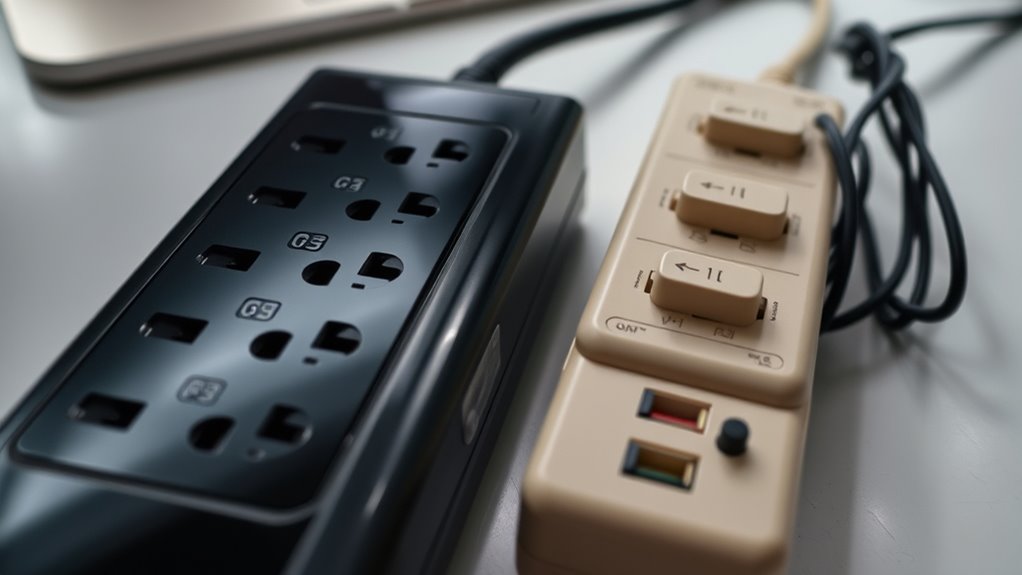
When weighing cost and longevity, surge protectors often require a higher initial investment but tend to last longer due to their protective components. Over time, they can save you money by preventing damage to electronics, reducing replacement costs. Power strips are cheaper upfront but may need frequent replacement, especially if they lack surge protection. To assess value:
- Surge protectors generally last 3-5 years or longer if properly maintained.
- Power strips typically need replacement every 1-2 years.
- Quality surge protectors include features like indicator lights to show protection status, adding to their value.
Ultimately, investing in a surge protector provides better long-term value, especially for sensitive electronics, despite the higher initial cost.
Frequently Asked Questions
Can a Power Strip Be Converted Into a Surge Protector?
You might wonder if a power strip can become a surge protector. While some power strips claim to have surge protection, many don’t offer reliable defense against power surges. To truly convert a power strip into a surge protector, you’d need to add a surge protection device or replace it with a dedicated surge protector. Relying on a basic power strip won’t protect your devices from sudden voltage spikes.
Are There Any Brands Known for Reliable Surge Protectors?
Ever wonder which brands stand tall in the domain of reliable surge protectors? You’ll find that brands like APC, Belkin, and SurgeGuard consistently earn top marks for protection and durability. These companies are the knights in shining armor for your electronics, shielding them from power surges. Trust these names to keep your devices safe, just as a sturdy fortress guards its treasures. Their reputation is well-earned, ensuring peace of mind for your valued gadgets.
How Often Should I Replace My Surge Protector?
You should replace your surge protector every few years or if it shows signs of damage, such as frayed cords, scorch marks, or frequent tripping. Over time, surge protectors lose their ability to shield your devices from power surges. Regularly check your unit and replace it when necessary to keep your electronics safe. Remember, a reliable surge protector is an investment in your devices’ longevity and safety.
Can Multiple Surge Protectors Be Plugged Into Each Other?
Think of plugging multiple surge protectors into each other like stacking dominoes—it’s a risky game that can topple your safety. You shouldn’t connect surge protectors together; it can overload the circuit, reduce protection, and create a fire hazard. Always plug your devices directly into a single surge protector or power strip, and avoid daisy-chaining them. Your safety depends on keeping things straightforward and avoiding unnecessary risks.
Do All Power Strips Include Surge Protection Features?
You might wonder if all power strips have surge protection, but not all do. Many basic power strips only provide extra outlets without safeguarding your devices from power surges. If protection is your goal, look for a power strip with built-in surge protection features, usually indicated by a light or label. Always check the product specifications to verify it offers the safety and protection you need for your electronics.
Conclusion
Choosing between a surge protector and a power strip is like selecting the right shield for your treasure chest. While power strips are handy extensions, surge protectors act as vigilant guardians, fending off dangerous power surges. By understanding their differences, you can safeguard your devices like a seasoned knight guarding precious jewels. Make the right call, and let your electronics thrive in a fortress built with wisdom and care.
